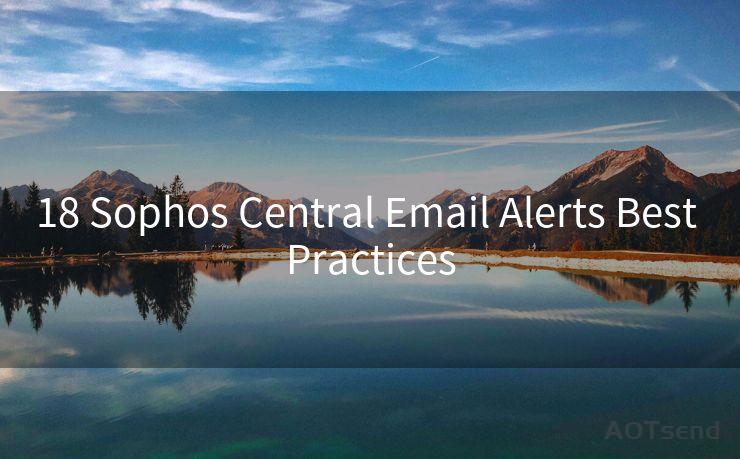18 Sophos Central Email Alerts Best Practices




1. Introduction
In the ever-evolving landscape of cybersecurity, staying vigilant and proactive is crucial. Sophos Central, a leading cloud-based security platform, offers robust protection against threats. One of its key features is email alerts, which provide timely notifications about potential security risks. In this article, we explore 18 best practices for configuring and using Sophos Central email alerts to enhance your organization's security posture.
2. Understand Alert Types
Sophos Central offers a variety of alert types, ranging from malware detections to system updates. Understanding the different types of alerts and their severity levels is essential for effective management. Ensure your team is familiar with each alert and its implications.
3. Customize Alert Settings
Sophos Central allows you to customize alert settings based on your organization's needs. Tailor your alert preferences to receive notifications for events that are most relevant to your environment. This helps reduce noise and focus on critical events.
4. Designate an Alert Response Team
Create a dedicated team responsible for monitoring and responding to Sophos Central alerts. This team should be trained to quickly assess and mitigate threats.
5. Establish Escalation Procedures
Develop clear escalation procedures for handling different types of alerts. Have a plan in place for when and how to escalate issues to higher-level support or management.
6. Regularly Review and Update Alert Configurations
As your organization's needs and the threat landscape evolve, it's important to regularly review and update your alert configurations. Ensure they remain relevant and effective.
7. Utilize Alert Templates
Sophos Central provides alert templates that can be customized to fit your organization's needs. These templates can help standardize your response to different types of alerts.
8. Integrate with Other Systems
Integrate Sophos Central alerts with other IT and security systems, such as SIEM (Security Information and Event Management) solutions, for a comprehensive view of your security posture.
9. Monitor and Respond to False Positives
While Sophos Central is highly accurate, false positives can occur. It's important to monitor these instances and fine-tune your alert settings to reduce them.
10. Archive and Analyze Alert Data
Maintain an archive of alert data for historical analysis. This can help identify patterns and trends, allowing you to proactively address potential issues.
11. Train Employees on Alert Response
Provide regular training to employees on how to respond to Sophos Central alerts. This ensures a swift and effective response when a real threat occurs.
12. Use Alert Data for Compliance Reporting
Sophos Central's alert data can be used for compliance reporting, demonstrating your organization's commitment to security best practices.
13. Leverage Automation
Utilize automation tools to streamline the handling of Sophos Central alerts. This can help reduce response times and improve efficiency.
14. Maintain Updated Contact Information
Ensure that all contact information for alert notifications is up to date. This includes email addresses, phone numbers, and any other communication channels used for alerts.

15. Regularly Test Alert System
Periodically test your alert system to ensure it's functioning properly. This includes sending test alerts and verifying that they are received and processed correctly.
16. Document Alert Procedures
Document all procedures related to Sophos Central alerts, including response plans, escalation paths, and contact information. This ensures everyone is on the same page during an incident.
17. Continuously Monitor and Adjust
The effectiveness of your alert system depends on continuous monitoring and adjustment. Regularly review alert data, identify trends, and make necessary adjustments to improve your security posture.
18. Stay Updated on Sophos Central Features
Sophos Central continuously evolves, adding new features and improving existing ones. Stay updated on these developments to ensure you're leveraging the platform's full potential.
🔔🔔🔔
【AOTsend Email API】:AOTsend is a Managed Email Service for sending transactional emails. Support Email Types: reminders, authentication, confirmations, notifications, verification codes, invoices, password resets, account activations, billing statements, two-factor authentication (2FA), and one-time passwords (OTP) emails, etc. $0.28 per 1000 Emails. 99% Delivery, 98% Inbox Rate.
You might be interested in:
Why did we start the AOTsend project, Brand Story?
What is a Managed Email API, How it Works?
Best 25+ Email Marketing Platforms (Authority,Keywords&Traffic Comparison)
Best 24+ Email Marketing Service (Price, Pros&Cons Comparison)
Email APIs vs SMTP: How they Works, Any Difference?
By following these best practices, you can ensure that your organization is effectively utilizing Sophos Central's email alert system to enhance your cybersecurity posture. Remember, a proactive approach to security is always better than a reactive one.




Scan the QR code to access on your mobile device.
Copyright notice: This article is published by AotSend. Reproduction requires attribution.
Article Link:https://www.mailwot.com/p6902.html



